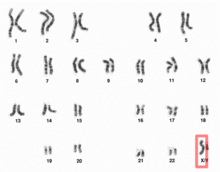| Human X chromosome | |
|---|---|
Human X chromosome (after G-banding) | |
 X chromosome in human male karyogram | |
| Features | |
| Length (bp) | 154,259,566 bp (CHM13) |
| No. of genes | 804 (CCDS) |
| Type | Allosome |
| Centromere position | Submetacentric[1] (61.0 Mbp)[2] |
| Complete gene lists | |
| CCDS | Gene list |
| HGNC | Gene list |
| UniProt | Gene list |
| NCBI | Gene list |
| External map viewers | |
| Ensembl | Chromosome X |
| Entrez | Chromosome X |
| NCBI | Chromosome X |
| UCSC | Chromosome X |
| Full DNA sequences | |
| RefSeq | NC_000023 (FASTA) |
| GenBank | CM000685 (FASTA) |
The X chromosome is one of the two sex chromosomes in many organisms, including mammals, and is found in both males and females. It is a part of the XY sex-determination system and XO sex-determination system. The X chromosome was named for its unique properties by early researchers, which resulted in the naming of its counterpart Y chromosome, for the next letter in the alphabet, following its subsequent discovery.[3]
- ^ Tom Strachan; Andrew Read (2 April 2010). Human Molecular Genetics. Garland Science. p. 45. ISBN 978-1-136-84407-2.
- ^ Genome Decoration Page, NCBI. Ideogram data for Homo sapience (850 bphs, Assembly GRCh38.p3). Last update 2014-06-03. Retrieved 2017-04-26.
- ^ Angier, Natalie (2007-05-01). "For Motherly X Chromosome, Gender Is Only the Beginning". The New York Times. Retrieved 2007-05-01.